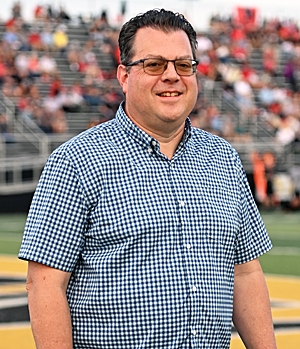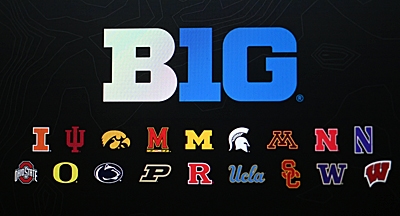
“Whatever it takes to win the game is what we got to do. But it all comes down to how physical we are running the football and stopping on the run.” – Ryan Day. (Press Pros Feature Photos)
So many of the things that used to matter in college football about how you win don’t mean as much as they used to. And the Buckeyes are figuring that out, making improvements and feeling better about who they are no matter the final score.
 Columbus, OH – A win is a win more than it’s ever been.
Columbus, OH – A win is a win more than it’s ever been.
That’s the best news the 2024 Ohio State football team could get. Because pretty is not a word that describes the Buckeyes’ wins over Nebraska and Penn State. But it doesn’t matter.
Every metric – measured by math or the eyes – doesn’t mean what it used to. The rule changes that make for fewer possessions and fewer plays make it more difficult to run up big scores. And the new playoff system splits fewer hairs because of automatic bids for conference champions and 12 spots available instead of four.

Veteran columnist Jeff Gilbert writes Ohio State football and OHSAA sports for Press Pros Magazine.com.
Win, win, win and you’re in.
The Buckeyes are doing that and will be favored the remaining weeks of the regular season to continue winning. They put themselves on the control-your-own-destiny path with a gritty, grinding win at Penn State. And it didn’t have to be pretty or turnover-free because of the toss-up nature of the game pitting two top-five teams.
All of this is good for Ohio State’s postseason positioning. It frees the players and coaches to not worry about how they win. And that’s good for their psyche.
Day said Tuesday that since Saturday he’s thought about the effects of the way the game has change the past two seasons. Previously, he expressed anxiety over not getting to run as many plays and score as many points because of a faster-moving clock. But that was under the old playoff model in which those kinds of aesthetics mattered more under the umbrella of style points.
“I don’t remember finishing a game with five-some-odd minutes on the clock,” he said of final clock-killing drive at Penn State. ‘We’re not snapping the ball at 20 seconds, so the number of plays are way, way down. It’s almost more like an NFL style game because you’re huddling.”
With fewer chances to score, it’s good for the coaches to be able to focus on simply winning and not by how much. Everyone wants to play well and look good doing it, but now it’s not mandatory. Some of the pressure is off. And other pressures have shifted.
“Situational football becomes more and more important – certainly much different than it was five years ago when it was just back and forth in high-scoring games,” Day said. “So efficiency and execution are at an all-time high.”
And that’s what coaches love to coach. Play well and winning – no matter by how much – is all that matters in a survive-and-advance sport.
Still, that doesn’t mean Day wants to rely on a fourth-quarter escape hatch every week. He still wants to eliminate turnovers and win the rushing yards to leave no doubt. But coaches will also tell you that adversity is the greatest factor in growth and learning how to win close games.
Therefore, outlasting the stress of the fourth quarter at Penn State is possibly what the Buckeyes’ psyche needed most. A runaway win, which it could have been without turnovers, might build confidence. But it can also build overconfidence. And overconfidence eventually results in negative results.
Some of the adversity the Buckeyes faced at Penn State was self-inflicted. But they have the leadership of quarterback Will Howard. His psyche, one this team seems to be tapping into, refuses to wallow in his mistakes no matter how much he hates them. Mistakes like an interception returned for a Penn State touchdown and the fumble that cost Ohio State a touchdown.
Next play, he says. You can’t change the past.
“He’s got a knack for that,” Day said.

Logan Services, in Dayton, Cincinnati, an Columbus, is a proud sponsor of area sports on Press Pros.
Howard’s move-on attitude – a trait he developed at Kansas State when he realized he had to stop letting turnovers affect his focus – is a leadership trait that helped Ohio State win 20-13.
If Howard and his teammates had let a 10-0 deficit cloud their focus, life is a lot different for the Buckeyes. There’s no video of players and coaches dancing in the locker room. There’s no No. 2 position in the first College Football Playoff rankings.
But most importantly for the Buckeyes, there’s no fourth-quarter performance that this team’s psyche needed. The goal-line stand and run-out-the-clock drive didn’t just win a football game. The Buckeyes now know something they had only previously hoped.
They confirmed the idea that they have what it takes to win games in the fourth quarter. They needed that jolt of confidence after failing at Oregon. The game-winning drive and stops against Nebraska helped. But they needed to do it against a team like Penn State to boost their psyche.
Winning difficult games, winning by grinding through tight games and not gliding through blowouts, is good enough in this era. And it allows the identity of this team to be as simple as what Day said he wanted this year: Be the hardest working team in America.
“A win is a win,” he said.
Losing difficult games can also help a coaching staff change what needs changed.
That’s what the Oregon game did. The Buckeyes couldn’t stop Oregon’s in the fourth quarter. It never generated a pass rush. And fears abounded among fans that maybe this team isn’t as good as we thought.
 “We almost – it’s kind of goofy word – re-engineered the defense, we almost started from scratch after the Oregon game,” Day said. “What I mean by that is not scrap everything, but what are the base foundations of what we’re trying to get done? Who are our best players?”
“We almost – it’s kind of goofy word – re-engineered the defense, we almost started from scratch after the Oregon game,” Day said. “What I mean by that is not scrap everything, but what are the base foundations of what we’re trying to get done? Who are our best players?”
Jim Knowles spoke Tuesday after Day and affirmed everything Day said. And he said he’s as comfortable as he’s been coaching this defense the way he wants to. And it showed with two goal-line stands, more and different kinds of quarterback pressures and in the play of safety Caleb Downs who is building a reputation as one of the elite defenders in the country.
And the Nebraska game made them focus on the running game. The loss of Josh Simmons at left tackle took the initial blame for the poor rushing performance against the Cornhuskers. But to Day’s credit, offensive coordinator Chip Kelly’s credit and line coach Justin Frye’s credit, they fixed it.
Moving Donovan Jackson from guard to tackle on the left side was the only option. But choosing the right player at guard was a move the staff had to get right. And they did with sophomore Carson Hinzman.
Hinzman was pushed into the starting center spot way ahead of schedule last year. So Frye recruited Seth McLaughlin out of the transfer portal away from Alabama to be the starting center. But, in an example of how less than ideal circumstances can lead to a future benefit, Hinzman’s experience made him the choice to be the left guard. And it’s his spot to lose after he, along with Jackson, graded out as a champion.
“After watching the film, he stepped up in a big way and showed us that he can play guard,” Day said. “Carson has toughness. Carson has athleticism. Carson’s smart.”
 The Buckeyes talk about how it could be a long season of 16 or 17 games if they reach their national title goal. And they are learning how to navigate it. Make changes when necessary. Lean on your leaders. And don’t worry about style points and rankings.
The Buckeyes talk about how it could be a long season of 16 or 17 games if they reach their national title goal. And they are learning how to navigate it. Make changes when necessary. Lean on your leaders. And don’t worry about style points and rankings.
It’s all so liberating to be able to simply focus on the controllables that happen on the field.
“Whatever it takes to win the game is what we got to do,” Day said. “But it all comes down to how physical we are running the football and stopping on the run.”
That part hasn’t changed.




